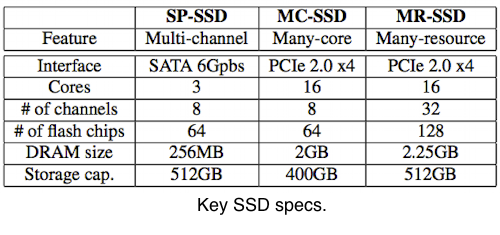Anyone looking at how flash SSDs have revolutionized power constrained mobile computing could be forgiven for thinking that all SSDs are power-efficient. But they’re not.
In a recent Usenix HotStorage ’14 paper Power, Energy and Thermal Considerations in SSD-Based I/O Acceleration researchers Jie Zhang, Mustafa Shihab and Myoungsoo Jung of UT Dallas examine what they call “many-resource” SSDs, those with multiple channels, cores and flash chips.
Their SSD taxonomy divides SSDs in terms of interfaces, cores, channels, flash chips and DRAM size. There’s no one metric that defines a many-resource SSD but the entire gestalt of the device. Here’s their breakdown:
The price of performance
Each flash die has limited bandwidth. Writes are slow. Wear must be leveled. ECC is required. DRAM buffers smooth out data flows. Controllers run code to manage all the tricks required to make an EEPROM look like a disk, only faster.
So the number of chips and channels in high performance SSDs has risen to achieve high bandwidth and low latency. Which takes power and creates heat.
Testing
They ran 3 different real SSD testbeds on a quad-core i7 system with an in-house power monitor and an application to capture detailed SSD info such as temperature. They tested both pristine and aged SSDs, running I/O sequential and random workloads that ran from 4KB to 4MB.
Key findings
The many-resource SSD exhibits several characteristics not usually associated with SSDs.
- High temperatures. 150-210% higher than conventional SSDs, up to 182F.
- High power. 2-7x the power, 282% higher for reads, up to 18w total.
- Performance throttling. At 180F the many-resource SSD throttles performance by 16%, equivalent to hitting the write cliff.
- Large write penalty. Writes at 64KB and above in aged devices caused the highest temperatures, presumably due to extra overhead for garbage collection and wear leveling.
Performance throttling was not limited to the high-end SSDs. The mid-range many-core drive slowed down at 170F, probably due to thermally-induced malfunction as the drive had no autonomic power adjustment.
The StorageMojo take
This appears to be the first in-depth analysis of the power, temperature and performance of a modern high-end SSD. The news should be cautionary for system architects.
For example, one new datacenter PCIe SSD is spec’d at 25w – higher than the paper found on slightly older drives. That’s twice what a 15k Seagate requires.
The slowdown seen for large writes suggests caution when configuring SSDs for write-intensive apps. Almost by definition the performance hit will come at the worst possible time.
StorageMojo commends the researchers for their work. It’s important that we have good data on actual today’s SSD behavior instead of impressions gained years ago with simpler and slower devices. If high-performance SSDs loom large in your planning the paper is well worth a read.
Courteous comments welcome, of course. What surprises you the most about this research?



Hi Robin,
To me, the link in your blog leads back to the blog entry. I think the link to the paper is here:
https://www.usenix.org/system/files/conference/hotstorage14/hotstorage14-paper-zhang.pdf
Regards,
Scott
Thanks! Fixed.
Robin